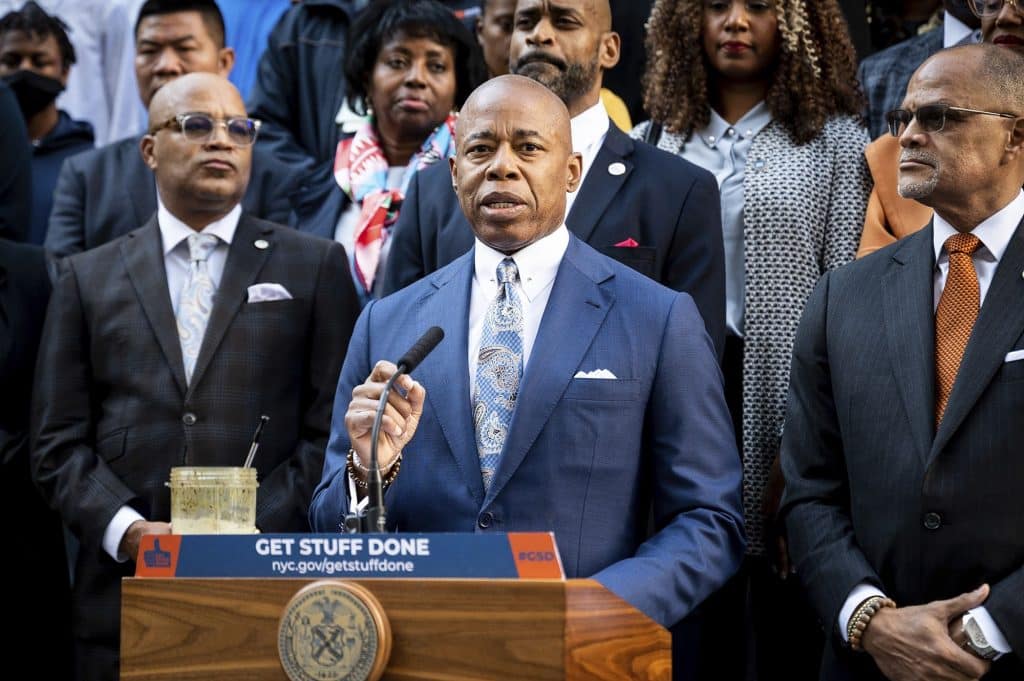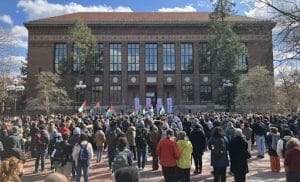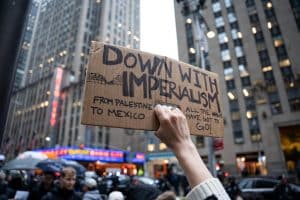New York City mayor Eric Adams declared in August that there is “no room” in the city for hundreds of migrants being forced to sleep on the street because shelters are already crowded and in disrepair. The mayor initially encouraged those seeking shelter to “consider another city” as they struggled to survive. Adams announced plans to house as many as 2,000 in a tent complex on Randalls Island and later designated space on an airfield to house asylum seekers. These spaces are identified, as the claim goes, that the city simply doesn’t have housing space for those seeking asylum, especially because it is already difficult enough for residents to find adequate, affordable housing. This housing crisis is not limited to New York as people struggle to find affordable housing throughout the country and many more continue to come to the U.S. Adams’s remarks came as Texas governor Greg Abbott installed barrels wrapped in razor wire in order to keep migrants from crossing the Rio Grande. Abbott had already been busing thousands of migrants to sanctuary cities, claiming that his state’s resources should go to U.S. citizens, even as children die during transport.
Whether Democrat or Republican, capitalist politicians fallaciously claim that there is “not enough room” or “not enough resources” for the residents of their state, let alone those migrating to the U.S. from other countries. We have heard this lie before. An 18-month investigation by the Guardian, for example, detailed how states send homeless people with one-way tickets from one city to another so they do not have to dedicate resources to providing shelter in their state. As climate disaster and global conflict drive people from their homes, the U.S. is set to see more people migrating, seeking safety, and this rhetoric of there being “no room” in the U.S. is likely to intensify. In reality, though, there is more than enough housing and resources in the U.S. for everyone who needs it. The housing crisis is a crisis of capitalism, one that capitalist politicians and the state uphold and defend.
Racism Central to the Crises
There is a confluence of factors, beyond the scope of this piece, that led to the current housing crisis in U.S., factors that existed long before the so-called migrant crisis now affecting areas of the U.S. And while the crisis of housing under capitalism affects all sectors of the poor and working class, Black, Indigenous, and Latino folks disproportionately make up the unhoused (as do single mothers). Similarly, many of the migrants coming to the U.S. are people of color coming from South American countries. Knowing how racism is weaponized to divide sectors of the poor and working class, we can see how the criminalization of homelessness and the criminalization of migration are tied together through racism. Racism is at the heart of early capitalist accumulation and the origins of the system itself. It’s central to housing policy, which has led to the current housing crisis and criminalization of homelessness. It’s central to capitalists’ rhetoric in response to the migrant crisis today as we see claims that those coming to the U.S. will do anything from take jobs to cause violence to monopolize resources that could go to residents of cities. All these tropes serve to divide oppressed group against oppressed group, so anger is directed away from a system which causes — and then looks for ways to capitalize from — from crises time and time again. Racism and systemic oppression are tied deeply to the interests and mechanisms of control of capitalism as special oppression is integral to maintain the system’s functioning.
“Affordable” Housing?
When it comes to conversations on housing or the cities poorest and most marginalized throughout the U.S., they often center on space in the shelter system and the availability of “affordable housing.” But the shelter systems throughout the U.S. are often overcrowded and under resourced. In New York, for example, people are forced to live in such squalid and dangerous conditions that many would rather live on the street. Meanwhile, politicians like Mayor Adams, who pretends he would like to help if it weren’t for there being “no more room,” recently vetoed bills that would help people get out of shelters and into permanent housing. Adams even requested that the city’s long-standing “right to shelter” be eliminated, because, he claimed, he didn’t want to increase taxes for New Yorkers and wanted leeway for using the city’s “limited resources.”
To look at some data on “affordable” housing in New York, most rent is too expensive for a working-class family to afford regardless of the “affordable” designation. Of those apartments deemed “affordable,” many are held off the market for rent by profit-seeking landlords. Depending on the survey, the estimates range wildly from 2,000 to 60,000 rent-stabilized units (a number that varies and could be much higher, since landlords often purposely fail to submit accurate data) held off market for a variety of reasons. Often, landlords won’t get them up to par because they claim it is not cost effective for them as they cry broke. These apartments are then held empty in a process called “warehousing.” While exact numbers are unavailable, it is even suspected that landlords throughout the city attempt to holding an apartment in the hope that one next to it will become vacant so they can combine them into one unit, allowing them to remove it from the rent stabilization roll in a process known as “Frankensteining.”
These tactics aren’t limited to New York. Politicians everywhere are constantly at odds with landlords who want to maximize their bottom line in attempts to get a few more “affordable” spaces open. In California, for example, companies like Blackstone buy up properties and then raise rents. Companies then inevitably push back against making more affordable units. Since under capitalism, housing is not a basic human right, landlords are free to do what they please. As a result, many people end up homeless because they can’t pay rent. Unfortunately, neither party in the U.S. is willing to confront capitalists or landlords, which leaves the working class victim to the endless pursuit of profit. Really, any discussion around a lack of “affordable” housing — a discussion capitalist politicians on both the Left and Right are willing to debate ad nauseam — is laughable, because it comes down to the fact that we live under a system that prioritizes profits over people having a place to live.
Plenty of Housing for Everyone
Focusing on “affordability” misses the point. New York — and many other major cities throughout the U.S. — has plenty of housing for anyone who needs it, including any and all people migrating from outside the U.S. looking for shelter. You just have to look in the right places. Starting with residentially zoned properties, data from Mansion Global — yes, a publication with that name does exist, which has to be one of the bourgeois-est of the bourgeois press — shows that after billions were spent to build luxury apartments meant to attract the rich from all over the world at both 15 and 35 Hudson Yards, half remain empty as thousands of New Yorkers sleep on the street every night. According to the New York Post, half of the apartments in another area of housing for the richest in the world, known as “billionaires row,” also remain empty. These are apartments owned by the world’s richest, so it’s good to remember that even if they are owned by someone, they are often vacant. While the data is now somewhat dated, New York magazine cited census data estimating that “30 percent of all apartments in the quadrant from 49th to 70th Streets between Fifth and Park are vacant at least 10 months a year.” Real estate purchases for the world’s richest often serve as ways for capitalists to hide their wealth and act as another pad to stop by every once in a while for fun. Who even owns much of the property in New York is hard to pin down, since the rich from around the world hide records of the ownership in trusts, limited liability companies, and other entities, as found by an extensive New York Times exposé.
The theme of people needing housing and there being more than enough space to house them extends far beyond New York City. The three cities in the U.S. with the highest populations of people without housing are New York, Los Angeles, and Seattle. Many cities have thousands of apartments or homes owned by the world’s wealthiest that could house those who need it. In Detroit, for example, there are more vacant homes per homeless individual than anywhere else in the country, with 116 empty homes per unhoused person. In Chicago, over 300,000 of the roughly 3 million homes remain vacant as the unhoused population continues to grow. And the housing crisis isn’t limited to cities. Right now, there are more homes than homeless people in the U.S. According to a study by United Way NCA, “There are currently 28 vacant homes for every one person experiencing homelessness in the U.S.” Moreover, this situation is not limited to the U.S. While it could be argued a portion of these homes are in disrepair making them not livable, this only underscores the need to place people in empty homes instead of leaving them empty as landlords try to maximize their bottom line. Having people living in homes gives them the chance to take care of the place where they live and helps maintain a country’s housing stock.
The number of unhoused people continues to grow, increasing by 11 percent over the past year, the largest increase in the last 15 years. This has taken place as conditions have become even more dire for many around the country. The COVID-19 pandemic pushed more people into economic precarity, and now things have become worse for many as many of the pandemic related government relief programs — including anti-eviction measures, rental assistance, and child tax credits — are ending, and many are losing healthcare coverage. This, combined with ongoing imperialist wars around the globe and increasingly frequent climate disasters, has led many people to flee their homes (for example, the migrants Adams claims there is “no room for”). But there could be housing for everyone who needs it right now.
To be clear, space for housing doesn’t have to be limited to residentially zoned properties. Commercially zoned properties such as office buildings could be refitted to be used as housing. After the COVID-19 pandemic, much has been written about business districts falling on “hard times” as employees seek opportunities to work remotely. As Slate reports,
According to data from the brokerage Colliers, almost all of the biggest office buildings in downtown Los Angeles are underwater on their loans. … The city’s biggest commercial landlord, the Canadian property giant Brookfield, has defaulted on more than a billion dollars of loans this year.
This has raised concerns about a so-called doom loop, in which large commercial landlords default on their loans, lowering city revenues from property taxes and leading to “revenue-strapped public services and diminished urban activity, each worsening the other.” But in a world where housing the public was a main concern, this could open space for repurposing these office buildings and other commercial spaces for housing for those who need it. Instead, spaces are held vacant as large landlords wait for the economic situation to “improve” while millions go without shelter.
The Problem: The Capitalist State
What it comes down to is not that there is “no room” in major cities or throughout the U.S., as Mayor Adams claims regarding New York. It’s that under capitalism the interests of property owners trump what should be a human right, housing. There is also plenty of room for housing for anyone who comes to the U.S. Housing them would just require threatening the interests of the world’s most wealthy. Adams, like any other capitalist politician, would rather protect the interests and property of wealthy capitalists than see people with housing. Mayors like Adams would rather see residents living on the street struggling to survive than even make the most minor reforms of increasing taxes on the richest or remotely threaten the interests of wealthy landlords.
Under capitalism, housing has multiple functions. It is an aspect of infrastructure necessary for social reproduction, but like every other aspect of life under this system, it also becomes a commodity to be profited from. Over the years corporations have looked for more ways to profit from housing as much as possible, some calling this the “financialization of housing.” This refers to structural changes in housing and financial markets and global investment whereby housing is treated as a commodity, a means of accumulating wealth, and often as security for financial instruments that are traded and sold on global markets. These tactics occur globally as “financialized landlords” — including real estate investment trusts (REITs), private equity funds, financial asset management firms, and other investment vehicles — attempt to maximize profit whenever possible. Over time this process leads an aspect of infrastructure to be liquefied financially so it can be treated like a commodity with exchange value.
What’s key to recognize is the state’s role in this process and how it helps protect the interests of capitalists. The state helps create, and then weaponize, housing precarity and homelessness. As Nathaniel Flakin notes in his piece “How Would Lenin Solve the Housing Crisis?,”
The problem is the state. Reformists believe that the state is just an administrative body that will carry out the will of the government. Marxists, in contrast, understand that the state is an instrument of the ruling class to defend its privileges. In the last analysis, the state consists of the special bodies of armed men that defend the rule of a small minority (the capitalists) against the enormous majority (the workers).
The state continually fights to defend capitalists and, as a result, helps create dynamics that then allow politicians to claim there is a “lack of housing” or “no room” for migrants. Indeed, a study of the history of housing in Canada’s biggest city, Toronto, showed how the state actually helped create the “housing crisis” in that city. Discussing the financialization of housing in the city, the authors note,
State policy has enabled this trend through legislation to create new vehicles for financial investment in real estate, and through policies to decontrol rents, deregulate tenant protections, and withdraw from social housing provision. These policies have resulted in a landscape of crisis for tenants and of new opportunities for diverse investors.
This dynamic occurs among all capitalist governments, even so-called progressive ones. Flakin notes, for example, that even the administration of Ada Colau (a former squatter) in Barcelona has failed to make any meaningful changes in the city around housing. Even as the administration tried to take over empty apartments that had been foreclosed by the banks, courts stopped the measures. Meanwhile, the police continued evicting working-class families in order to guarantee profits for the banks.
As discussed above, racism is central to the maintenance of the capitalist system. State policy — discussed in works like Richard Rothstein’s The Color of Law, which shows the state’s role in housing segregation in the U.S. — has often been central to systematically keeping certain sectors of the population from having adequate housing. The state helps ensure that certain sectors of the population do not have housing, because this is essential to keeping the private property system in the clutches of power.
At the same time the state then uses homelessness and housing precarity to threaten the rest of the working class while using the police and court systems to uphold this threat. Capitalist governments essentially tell citizens, “Keep yourself in line, keep your head down, and sell your labor, or you too can lose your shelter.” The state tells us the system “works” if you keep your head down and stay in line, sell your labor to survive, etc. Those who lose their shelter are then further criminalized by the state: subject to raids of tents or other forms of shelter, arrested and brutalized by the police essentially for being impoverished.
But as we see more people fleeing their homes and risking their lives just to survive, the narrative that the state exists to “protect” or “provide” for the public begins to crumble. The system itself creates crises; this is why people are fleeing in the first place. If the level of housing insecurity weren’t already bad enough, protecting the interests of landlords and corporations over the public further burdens capitalist politicians and exposes the system itself. This at least partly explains why capitalist governments around the world are not open to embracing migrants. It’s why Greece opts not to save migrants on ships bound for its borders. It’s why Britain is keeping migrants on barges deemed “potential deathtraps” — a practice that shortly thereafter was shown to expose them to bacteria in the water supply.
Fight for Housing for All: We Need a Working-Class Party
There is plenty of housing for everyone who needs it, not just in the U.S. but around the globe. The real problem in any city is that the capitalist state defends the interests of private property over the interests of the general public. The dynamics of capitalism lead to the commodification of housing, which leads people to have insecure shelter in the first place. Then the system creates global conflict, war, and increasingly common climate disasters causing more and more to have to flee their homes. While capitalist politicians may attempt to tweak the system here and there, they ultimately act as representatives for a capitalist state, which defends the interests of capitalists over the public. To address these issues, we need to fight for a working-class party that fights for housing as a human right for all. We need to fight the capitalist system, which will never provide housing for those who need it.











